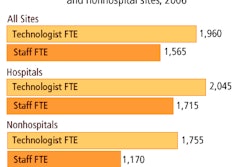
CHICAGO - People who receive liquid silicone for cosmetic purposes such as breast augmentation are at risk for a number of complications, including pulmonary embolism.
On chest radiographs, pulmonary emboli caused by silicone injections are characterized by diffuse parenchymal opacities, and on CT scan there is a "peripheral distribution of opacities with dominant ground-glass pattern," explained Dr. Carlos Restrepo, director of chest radiology at the University of Texas Health Science Center in San Antonio.
Restrepo reported on the adverse effects of the illegal subcutaneous injections at the 2006 RSNA meeting.
He said seven transsexual males were treated for silicone-induced pulmonary embolism at his hospital and included 37 additional cases reported in the literature.
Based on his experience, Restrepo advised that transsexual males who present with sudden onset respiratory distress and fever should be assessed for silicone emboli.
The U.S. Food and Drug Administration (FDA) recently agreed to allow two companies to again market silicone implants for breast augmentation or reconstruction. "That encapsulated silicone is the only silicone product that has ever received FDA approval," Restrepo said.
Nonetheless, liquid silicone, or polydimethylsiloxan fluid, remains a popular product in the underground, illegal cosmetic industry, he said.
The potential for silicone leaking into the blood stream to form emboli might be increased by the practice of following injection with massage to "smooth out the appearance of the injection site," he said.
The 25 of the 44 patients included in this analysis were transsexual males and 19 were females. The mean age of the patients was 31, and the most common site of injection was the breast followed by the buttocks.
Twenty-one of the patients, including one of the seven men treated in San Antonio, reported previous liquid silicone injections.
The onset of symptoms was rapid, usually within hours of injections, and the most common presenting symptom was respiratory distress followed by fever. Restrepo said, however, that bronchial lavage failed to identify any pathogens.
The mortality rate was 25% and the most significant finding at autopsy was alveolar hemorrhage.
When asked to estimate the prevalence of the use of liquid silicone injections, Restrepo said it was impossible to estimate, but stated that "this is a concern that should be brought to the attention of physicians and the general public."
By M. Mary Conroy
AuntMinnie.com contributing writer
December 4, 2006
Related Reading
Many silicone breast implants rupture within 10 years of surgery, July 25, 2003
Extracapsular silicone from breast implants might increase risk of fibromyalgia, June 11, 2001
Copyright © 2006 AuntMinnie.com



















